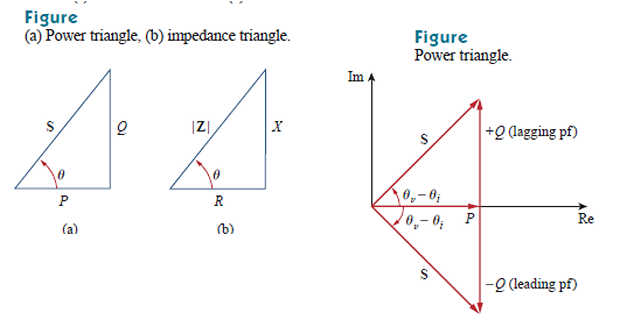Demonstrative Video
Complex Power
Complex power is important in power analysis because it contains all the information pertaining to the power absorbed by a given load.

The real power P is the average power in watts delivered to a load; it is the only useful power or actual power dissipated by the load.
The reactive power Q is a measure of the energy exchange between the source and the reactive part of the load. The unit of Q is the volt-ampere reactive (VAR).
\(Q=0\) for resistive loads (unity pf)
\(Q<0\) for capacitive loads (leading pf)
\(Q>0\) for inductive loads (lagging pf)

Revision
Complex Power Problems
Problem-1
The voltage across a load is \(v(t)=60 \cos \left(\omega t-10^{\circ}\right) \mathrm{V}\) and the current through the element in the direction of the voltage drop is \(i(t)=\) \(1.5 \cos \left(\omega t+50^{\circ}\right) \mathrm{A}\). Find: (a) the complex and apparent powers, (b) the real and reactive powers, and (c) the power factor and the load impedance.
- \[\mathbf{V}_{\mathrm{rms}}=\frac{60}{\sqrt{2}} \angle -10^{\circ}, \quad \mathbf{I}_{\mathrm{rms}}=\frac{1.5}{\sqrt{2}} \angle +50^{\circ}\]Solution: For the rms values of the voltage and current, we write
- \[\mathrm{S}=\mathbf{V}_{\mathrm{rms}} \mathbf{I}_{\mathrm{rms}}^{*}=\left(\frac{60}{\sqrt{2}} \angle -10^{\circ}\right)\left(\frac{1.5}{\sqrt{2}} \angle -50^{\circ}\right)=45 \angle-60^{\circ} \mathrm{VA}\]The complex power is
- \[S=|\mathbf{S}|=45 \mathrm{VA}\]The apparent power is
- \[\mathrm{S}=45 \angle -60^{\circ}=45\left[\cos \left(-60^{\circ}\right)+j \sin \left(-60^{\circ}\right)\right]=22.5-j 38.97\]complex power in rectangular form as
- \[P=22.5 \mathrm{~W} \qquad Q=-38.97 \mathrm{VAR}\], the real and reactive power are Since
- \[\mathrm{pf}=\cos \left(-60^{\circ}\right)=0.5 \text { (leading) }\]The power factor is
- \[\mathbf{Z}=\frac{\mathbf{V}}{\mathbf{I}}=\frac{60 \angle-10^{\circ}}{1.5 \angle+50^{\circ}}=40 \angle-60^{\circ} \Omega\]The load impedance is
Problem-2
A load \(\mathbf{Z}\) draws \(12 \mathrm{kVA}\) at a power factor of \(0.856\) lagging from a 120 -V rms sinusoidal source. Calculate: (a) the average and reactive powers delivered to the load, (b) the peak current, and (c) the load impedance.
Solution: Given \(\mathrm{pf}=\cos \theta=0.856\), \(\Rightarrow\) power angle \(\theta=\cos ^{-1} 0.856=31.13^{\circ}\).
- \[P=S \cos \theta=12,000 \times 0.856=10.272 \mathrm{~kW}\]\[Q=S \sin \theta=12,000 \times 0.517=6.204 \mathrm{kVA}\], then the average or real power is Apparent power is
- \[\mathrm{S}=P+j Q=10.272+j 6.204 \mathrm{kVA}\]is lagging, the complex power is Since the
- \[\mathbf{I}_{\mathrm{rms}}^{*}=\frac{\mathbf{S}}{\mathbf{V}_{\mathrm{rms}}}=\frac{10,272+j 6204}{120 \angle 0^{\circ}}=85.6+j 51.7 \mathrm{~A}=100 \angle 31.13^{\circ} \mathrm{A}\], we obtain From
- \[I_{m}=\sqrt{2} I_{\mathrm{rms}}=\sqrt{2}(100)=141.4 \mathrm{~A}\]and the peak current is Thus
- \[\mathbf{Z}=\frac{\mathbf{V}_{\mathrm{rms}}}{\mathbf{I}_{\mathrm{rms}}}=\frac{120 \angle 0^{\circ}}{100 \angle -31.13^{\circ}}=1.2 / 31.13^{\circ} \Omega\]The load impedance